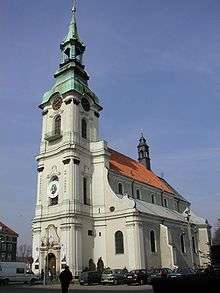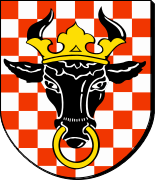Kalisz
| Kalisz | |||
|---|---|---|---|
|
Town Hall | |||
| |||
| Motto: Poloniae urbs vetustissima | |||
 Kalisz | |||
| Coordinates: 51°45′27″N 18°4′48″E / 51.75750°N 18.08000°E | |||
| Country |
| ||
| Voivodeship |
| ||
| County | city county | ||
| Established | 9th century | ||
| Town rights | after 1253 | ||
| Government | |||
| • Mayor | Grzegorz Sapiński | ||
| Area | |||
| • Total | 71.40 km2 (27.57 sq mi) | ||
| Population (2014) | |||
| • Total | 103,738 | ||
| • Density | 1,500/km2 (3,800/sq mi) | ||
| Time zone | CET (UTC+1) | ||
| • Summer (DST) | CEST (UTC+2) | ||
| Postal code | 62-800 to 62-821 | ||
| Area code(s) | +48 062 | ||
| Car plates | PK | ||
| Climate | Cfb | ||
| Website | Kalisz.pl (archived) | ||
Kalisz ([ˈkalʲiʂ]; German: Kalisch) is a city in central Poland with 103,738 inhabitants (June 2014), the capital city of the Kalisz Region. Situated on the Prosna river in the southeastern part of the Greater Poland Voivodeship, the city forms a conurbation with the nearby towns of Ostrów Wielkopolski and Nowe Skalmierzyce. See Kalisz County for the regional administrative area (powiat).
Kalisz is an important regional industrial and commercial centre, with many notable factories. The city is also a centre for traditional folk art. The town was also the site of the former 'Calisia' piano factory, until it went out of business in 2007.
Etymology
The name Kalisz might stem from either the Celtic term "cal" which means stream, or the Slavic term "kal", meaning swamp or marsh. Kalisz is one the oldest cities in Poland. There are many artifacts from Roman times in the area of Kalisz, indicating that the city has once been a stop of the Roman caravans heading for the Baltic Sea along the trade route of the Amber Trail.[1] Calisia (Kalisz in Polish) had been mentioned by Ptolemy in the 2nd century AD, although the connection is doubted by some historians who claim that the location mentioned by Ptolemy was situated in the territory of the Diduni in Magna Germania.
History

Archaeological excavations have uncovered early mediaeval settlement from the Piast dynasty period, c. 9th-12th centuries.[2] Modern Kalisz was most likely founded in the 9th century as a provincial capital castellany and a minor fort. In 1106 Bolesław III Wrymouth captured the town and made it a part of his feudal domain. Between 1253 and 1260 the town was incorporated according to the German town law called the Środa Śląska Law (after Środa Śląska in Silesia), a local variation of the Magdeburg Law, and soon started to grow. One of the richest towns of Greater Poland, during the feudal fragmentation of Poland it formed a separate duchy ruled by a local branch of the Piast dynasty. After Poland was reunited, the town became a notable centre of weaving and wood products, as well as one of the cultural centres of Greater Poland. Jewish settlement of Kalisz dates back to 1139 (see: Khalyzians).

In 1282 the city laws were confirmed by Przemysł II of Poland, and in 1314 it was made the capital of the Kalisz Voivodeship by king Władysław I the Elbow-high. Located roughly in the centre of Poland (as its borders stood in that era), Kalisz was a notable centre of trade. Because of its strategic location, King Casimir III the Great signed a peace treaty with the Teutonic Order there in 1343. As a royal town, the city managed to defend many of its initial privileges, and in 1426 a new town hall was built. The Polish king Mieszko III the Old was buried in Kalisz.[1]
In 1574 the Jesuits came to Kalisz and in 1584 opened a Jesuit College, which became one of the most notable centres of education in Poland; around this time, however, the importance of Kalisz began to decline somewhat, its place being taken by nearby Poznań.

The economic development of the area was aided by a large number of Protestant Czech Brothers, who settled in and around Kalisz after being expelled from Bohemia in 1620.
In 1792, fire destroyed much of the city centre. The following year, in the second partition of Poland, the Kingdom of Prussia absorbed the city, called "Kalisch" in German. In 1801, Wojciech Bogusławski set up one of the first permanent theatre troupes in Kalisz.
In 1807 Kalisz became a provincial capital within the Duchy of Warsaw. During Napoleon's invasion of Russia, following Yorck's Convention of Tauroggen of 1812, von Stein's Treaty of Kalisz was signed between Russia and Prussia in 1813, confirming that Prussia now was on the side of the Allies.
After the defeat of Napoleon Bonaparte, Kalisz became a provincial capital of Congress Poland and then the capital of a province of the Russian Empire. The proximity to the Prussian border accelerated economic development of the city and Kalisz ("Калиш" in Russian Cyrillic) started to attract many settlers, not only from other regions of Poland and other provinces of the Russian Empire, but also from German states. In 1902, a new railway linked Kalisz to Warsaw and Łódź.
With the outbreak of World War I, the proximity of the border proved disastrous for Kalisz; it was one of the first cities destroyed in 1914. Between August 2 and August 22 Kalisz was shelled and then burned to the ground by German forces under Major Hermann Preusker, even though Russian troops had retreated from the city without defending it and German troops – many of them ethnic Poles – had initially been welcomed peaceably. Eight hundred men were arrested and then several of them slaughtered, while the city was set on fire and the remaining inhabitants were expelled. Out of roughly 68,000 citizens in 1914, only 5,000 remained in Kalisz a year later. By the end of the Great War, however, much of the city centre had been more or less rebuilt and many of the former inhabitants had been allowed to return.[3]
After the war Kalisz became part of the newly independent Poland.[4] The reconstruction continued and in 1925 a new city hall was opened. In 1939 the population of Kalisz was approximately 89,000. After the German invasion of Poland in 1939, the proximity of the border once again proved disastrous. Kalisz was captured by the Wehrmacht almost instantly and without much fighting, and the city was annexed by Nazi Germany. By the end of World War II approximately 30,000 local Jews had been murdered. An additional 20,000 local Catholics were either murdered or expelled to the German-occupied territories (General Government) or to Germany as slave workers. In 1945 the population of the city was 43,000 – approximately half the pre-war figure.
In 1975, after Edward Gierek's reform of the administrative division of Poland, Kalisz again became the capital of a province – Kalisz Voivodeship; the province was abolished in 1998, however, and since then Kalisz has been the county seat of a separate powiat within the Greater Poland Voivodeship. In 1991 the city festival was inaugurated on June 11 to commemorate the confirmation of the incorporation of the city in 1282. In 1992 Kalisz became the seat of a separate diocese of the Catholic Church.
Religion
There are 19 Catholic Churches, 5 Protestant Churches, and one Orthodox Church in Kalisz. Before World War II there were 25,000 Jews in Kalisz, but most of them were murdered by the Nazis and by the summer of 1942 the Jewish community in Kalisz was entirely destroyed.
Education
Kalisz is a notable centre of education in the region. It is home to 29 elementary schools, primary schools, fifteen middle/junior high schools, and five high schools. Seven colleges and a dozen or so vocational schools are located there. The city is also home to branches of Poznań University, Poznań University of Economics, and Poznań University of Science and Technology, as well as several other institutions of higher education. It is a home to the Henryk Melcer Music School.
Economy
Although there is little heavy industry within the city limits, Kalisz is home to several of large enterprises. It is notable for the Calisia piano factory and for the Winiary and Ziołopex food processing plants (the former is now part of the Nestlé group), the Big Star jeans factory, and the Hellena, Jutrzenka, and Kaliszanka soft-drink production plants. Two plane engine production factories, WSK-Kalisz and Pratt & Whitney Kalisz (a branch of Pratt & Whitney Canada), are located in Kalisz.
Sports
- SSK Calisia Kalisz – women's volleyball team Champions of Poland,2nd place in 2003/2004 season and 1st place in 2004/2005 season
- KKS Kalisz – men's soccer team playing in the III liga.
Transport
Kalisz railway station was built in 1902 as the destination of the Warsaw–Kalisz Railway. It is currently served by Przewozy Regionalne and PKP Intercity.
Notable people from Kalisz
- Avraham Gombiner 1633 Jewish rabbi and scholar
- Wojciech Bogusławski 1757 playwright and director playwright
- Cyprian Godebski 1765 freedom fighter and a poet
- Julian Klemczyński 1807 or 1810–1851, composer
- Agaton Giller – (*1831 in Opatówek, Poland – +1887 in Stanisławów) – patriotic activist
- Stefan Giller – (*1833 in Opatowek, Poland – +1918) – poet, an epigone of the Polish Romanticism
- Adam Asnyk 1838 poet
- Juliusz Bursche 1862 bishop
- Jerzy Świrski 1882 – Vice-Admiral
- Maria Dąbrowska 1889 writer
- Theodor Meron 1930 president of the (ICTY) and judge in the International Criminal Tribunal for Rwanda
- Boleslaus the Pious, duke of Greater Poland
- Bolesław III the Generous, duke of Silesia
- Augustyn Kordecki, prior of the Jasna Góra Monastery and hero of The Deluge
- Jerzy Kryszak, actor
- Bonawentura Niemojowski, journalist
- Wincenty Niemojowski, journalist
- Ladislaus Pilars de Pilar – poet
- Wojciech Siemion, actor and director
- Zdzisława Sośnicka, singer
- Stefan Szolc-Rogoziński, traveller and explorer
- Stanisław Wojciechowski, president of Poland
- Alfred Wierusz-Kowalski, painter
- Jan Ptaszyn Wróblewski, musician
- Zvi Hirsch Chajes, 19th century Talmudic scholar
- Iga Wyrwał, Glamour model
- Eve Zaremba, writer
International relations
Twin towns — Sister cities
|
|
See also
- History of the Jews in Kalisz
- Kalisz Department (Polish: Departament Kaliski): a unit of administrative division and local government in Polish Duchy of Warsaw in years 1807–1815
- Kaliszanie
References
- 1 2 Anna Woźniak (2013), "Historia miasta Kalisz" (History of Kalisz) from the city's Official website. Internet Archive.
- ↑ Tadeusz Chrzanowski, "Kalisz", Sport i Turystyka, Warszawa 1978, Polish, German, English, French, Russian
- ↑ Maciej Drewicz: Kto zniszczył Kalisz (Who destroyed Kalisz). Dziennik Wielkopolski; Internet Archive Wayback Machine.
- ↑ Krystyna Dobak-Splitt, Jerzy Aleksander Splitt. "Odzyskanie niepodległości / powstanie wielkopolskie". Kalisz poprzez wieki. Stary Kalisz.pl. Retrieved October 3, 2012.
Kalisz poprzez wieki, Wydawca: Towarzystwo Miłośników Kalisza, 1988
- 1 2 3 4 5 6 7 8 9 10 Urząd Miejski Kalisz 2005–2008. "Kalisz: Miasta partnerskie" [Twin Towns]. Kalisz official website (Internet Archive). Retrieved 2016-07-12.
External links
| Wikimedia Commons has media related to Kalisz. |
-
 Kalisz travel guide from Wikivoyage
Kalisz travel guide from Wikivoyage - Members of Kalisz family from New Bedford, MA.
- Strona wspólnoty kaliskiej, "Klasztor » Rys Historyczny." Kościół franciszkański jest najstarszą świątynią zakonną w Kaliszu. Ufundowany został w roku 1256.
Coordinates: 51°46′N 18°05′E / 51.767°N 18.083°E



